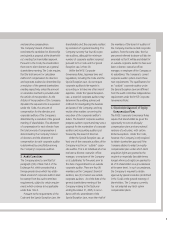Canon 2004 Annual Report Download - page 20
Download and view the complete annual report
Please find page 20 of the 2004 Canon annual report below. You can navigate through the pages in the report by either clicking on the pages listed below, or by using the keyword search tool below to find specific information within the annual report.
18
Environment-Conscious Management
and the Canon Environmental Charter
The Canon Environmental Charter was
enacted in 1993 to enunciate basic
concepts and policies for protecting the
environment under Canon’s corporate
philosophy, kyosei, and the EQCD
concept*1, which stands for environment,
quality, cost, and delivery. In 2001, the
charter was revised to incorporate
concepts for “maximization of resource
efficiency”*2based on the conviction that
the environment and the economy are
mutually sustainable through new
technologies and healthy social
mechanisms in the community.
In 2003, having further honed its
ideas, Canon devised Factor 2, an
overriding indicator for achieving environ-
mental targets. This indicator also provides
a visionary goal for the year 2010. One
aim of Factor 2 is to more than double
resource efficiency throughout the life
cycles of products within 10 years, from
2000 to 2010.
Canon fully recognizes its responsibility
as a manufacturer to focus on the product
life cycle and alleviate the environmental
burden. This concept is embodied in
Factor 2 as the ultimate means for counter-
acting environmental degradation. Based on
these ideas, Canon has set a goal of achieving
a 25% reduction in CO2emissions related
to sales from the 2000 level.
*1EQCD concept
Environment (environmental assurance): Companies
are not qualified to manufacture goods if they are
incapable of environmental assurance.
Quality: Companies are not qualified to market goods
if they are incapable of producing quality goods.
equipment (RoHS), has conducted
on-site
confirmations of the facilities of its suppliers.
Research and Development
As a regular part of the “prototype-less”
product development process, the design
information in Canon’s 3D-CAD systems is
checked automatically for environmental
attributes. This includes suitability for
recycling, environmental impact (LCA/LCC),
and the environmental qualities of its
parts. In addition, the elimination of the
need for prototypes saves resources.
Production
In production activities, Canon has intro-
duced the cell production method as a
Canon personnel conducted on-site verifications at the plants of its
suppliers to confirm lead-free operations in Suzhou, China.
The fundamental concept that aims to maximize resource efficiency has been defined by the Factor 2
concept. By 2010, Canon plans to double the efficiency of all its activities in comparison with 2000,
while cutting the environmental burdens associated with its businesses.
Fujio Mitarai
Cost, Delivery: Companies are not qualified to
compete if they are incapable of meeting cost
and delivery requirements.
*2Maximization of resource efficiency
“Achieving maximum efficiency in the use of
resources—in other words, offering the highest
quality standards for products and services, while
minimizing resource consumption and practicing
reuse and recycling. The key objective is to add as
much value as possible, using as few resources and
as little energy as possible.
Canon’s Environmental Burden
Canon’s business activities commence
with the receipt of raw materials and
components from its suppliers. The Compan
y
assembles these materials and components
into products that it then ships to sales
subsidiaries and other firms. Following
customer use, products are recycled to
the extent possible, and parts are reused.
The following paragraphs describe
Canon’s concern for the environment in
regard to the life cycles of its products.
Procurement of Materials and Components
Canon instituted its “Green Procurement”
program in 1997. Moreover, Canon took
the initiative in establishing the Japan
Green Procurement Survey Standardization
Initiative (JGPSSI), which prepares material
declaration guidelines. With major
electronics industry associations in the
United States (the EIA) and Europe (the
EICTA), JGPSSI is setting global standards
for material declarations.
At most of its plants worldwide, Canon
has installed equipment to analyze the
materials it procures, and, in anticipation of
the implementation of the European Directive
Restriction of the use of certain Hazardous
Substances in electrical and
electronic
Environment analysis equipment is used at the company’s
production facilities throughout the world.
CORPORATE FUNCTIONS
CORPORATE SOCIAL RESPONSIBILITY
























